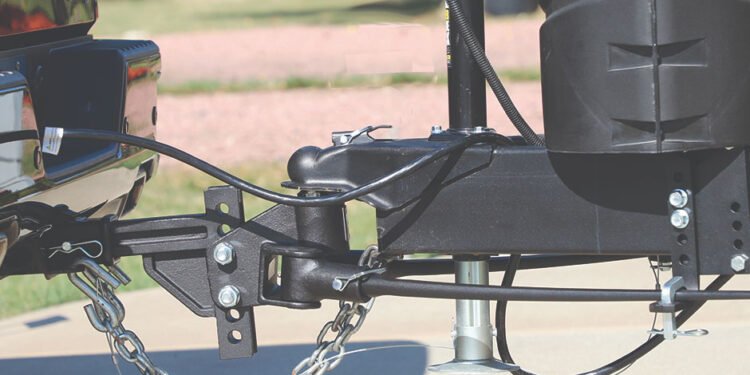Key Takeaways
- A weight distribution hitch (WDH) is essential for safe towing, especially when carrying heavy loads.
- WDHs help balance the trailer’s weight across a vehicle and enhance overall driving performance.
- Understanding the working mechanism of a WDH can significantly improve your towing experience.
- Ensure proper installation and usage for maximum benefits and safety.
Introduction to Weight Distribution Hitches
Towing heavy loads can be quite a challenge without the right equipment. A vital piece of equipment that may significantly impact is a weight distribution hitch (WDH). A WDH distributes the trailer’s weight evenly across the axles of a tow vehicle, enhancing balance and driving comfort. Boaters and RV vehicles must understand the importance of avoiding towing mishaps.
Why is a Weight Distribution Hitch Important?
A WDH is crucial for towing operations because it can prevent sagging and upward tilting, enhancing steering control and braking performance. Proper weight distribution extends the lifespan of vehicle components, reduces wear and tear on suspension and tires, and improves stability. It also improves fuel efficiency and reduces the vehicle’s risk of severe mechanical problems due to uneven weight distribution.
How Does a Weight Distribution Hitch Work?
A WDH is a system that redistributes the trailer’s tongue weight by applying an upward force on the trailer’s tongue via spring bars. This vehicle’s weight improves the tow vehicle’s stability and handling capabilities. When a trailer is hooked, the back axle of a tow vehicle experiences a downward force, which lifts the front end and affects the vehicle’s steering and braking capabilities. This mechanism enhances driving stability and minimizes suspension wear, resulting in a smoother ride.
Components of a Weight Distribution Hitch
- Hitch Receiver:The part that attaches to the tow vehicle.
- Shank:Connects the hitch head to the receiver.
- Hitch Head:Holds the spring bars and ball mount.
- Spring Bars:These bars apply leverage to redistribute weight.
- Chain and Bracket System:Helps adjust trailers in the spring bars.
The WDH system uses components, including the hitch receiver, shank, hitch head, spring bars, and ball mount. These elements balance weight, ensuring smooth towing experiences. The spring bars, positioned and tensioned with the chain and bracket system, distribute trailer weight evenly across the trailer’s sagging, optimizing vehicle stability.
Installation Tips for a Weight Distribution Hitch
For optimal performance, it’s crucial to install the WDH correctly. Here are some critical steps:
- Read the materials thoroughly.
- Attach the hitch receiver and securely mount it to the vehicle’s frame.
- Connect the shank and hitch head to the receiver, ensuring they are correctly aligned and fastened.
- Position and secure the spring bars appropriately, ensuring they are parallel to the ground.
- Adjust the chain and bracket system for proper tension, ensuring the trailer and tow vehicle are level.
This article provides a detailed guide on installing a WDH, emphasizing the importance of proper installation for maximum efficiency and road safety. Double-checking steps and making necessary adjustments can prevent issues during towing. Consulting the manufacturer’s guide ensures optimal setup and performance.
Benefits of Using a Weight Distribution Hitch
There are numerous benefits associated with the use of a WDH:
- Improved Handling:With an evenly distributed semitrailer, you can enjoy better steering control and overall vehicle stability, which is crucial when navigating turns or avoiding obstacles on the road.
- Enhanced Braking:Proper weight distribution hits improve braking distance and performance, ensuring safer stops by prevenmanufacturer’sehicle’s rear from being pushed down and the front from lifting.
- Increased Towing Capacity:Vehicle systems can boost your car’s towing capability, allowing you to safely and confidently pull more oversized loads.
- Reduced Wear and Tear:Balanced weight distribution reduces strain on the vehicle’s suspension and brakes, enhancing the longevity of these components and reducing maintenance costs over time.
The right WDH can transform your towing experience, making long hauls less strenuous and more enjoyable. By ensuring the tow vehicle and trailer operate as a cohesive unit, WDHs mitigate many common towing issues, providing peace of mind and a safer journey from start to finish. The manufacturer’s weight distribution hitch (WDH) is crucial for towing heavy trailers, campers, or boats. It ensures a safer and smoother journey but requires proper installation and following the system’s guidelines. Investing in a WDH is a proactive step towards safer, more efficient towing, ensuring a smoother journey without constant vehicle stability concerns.












